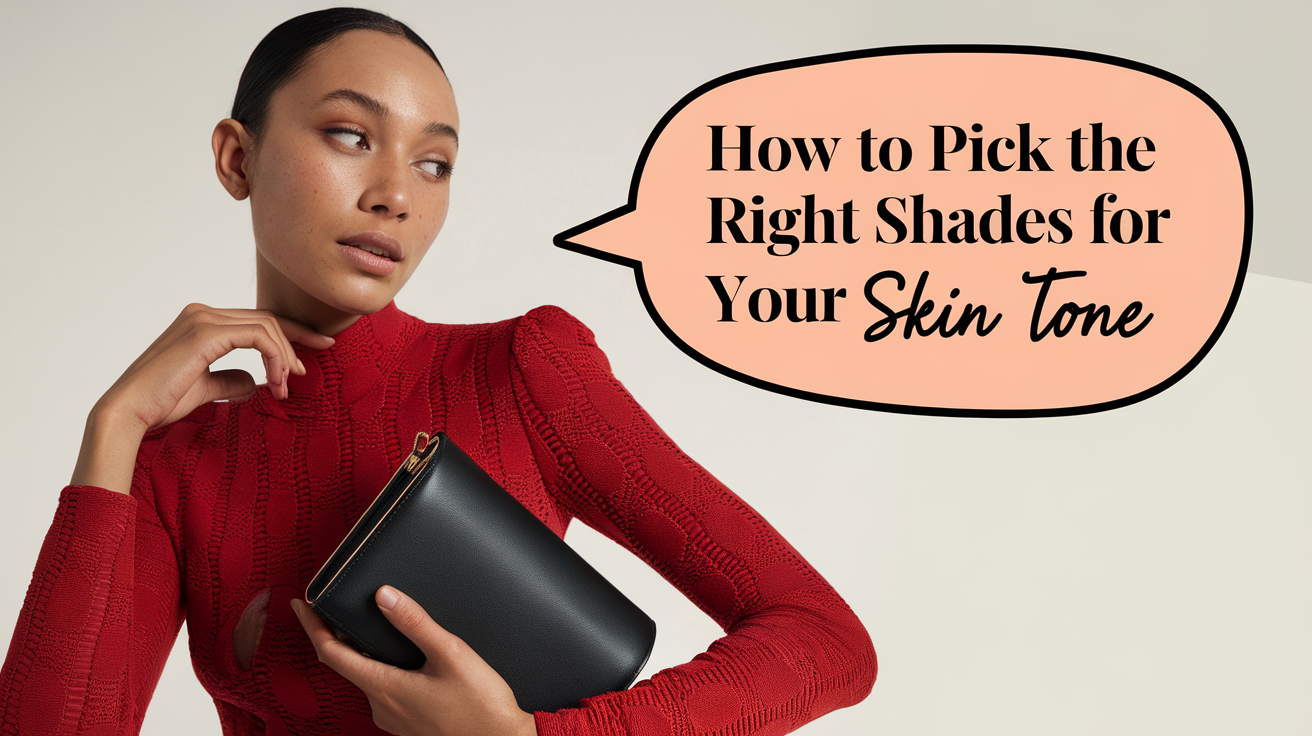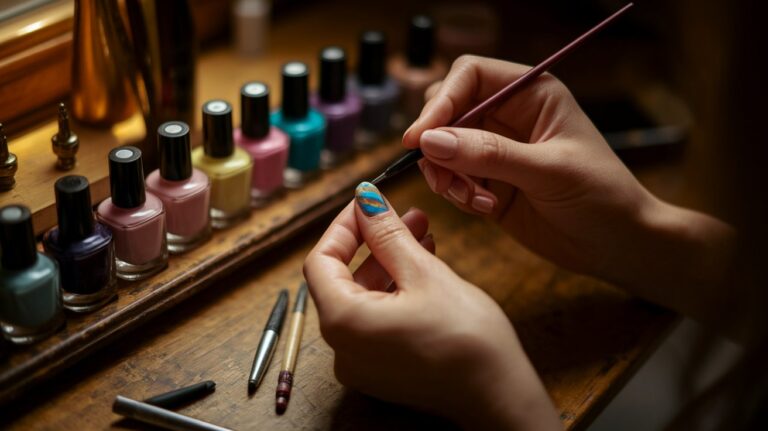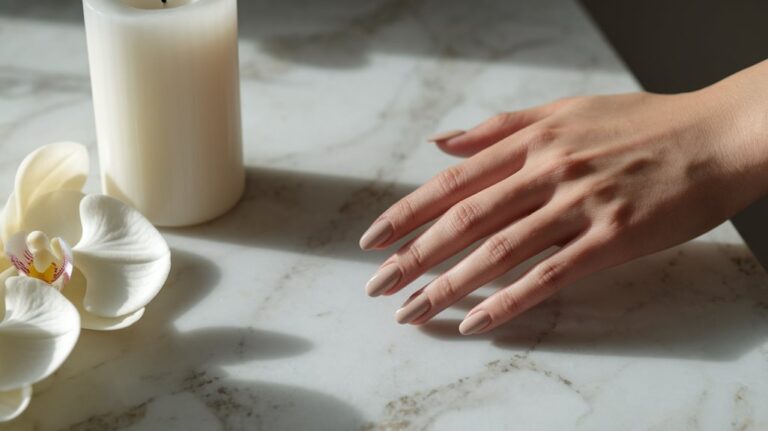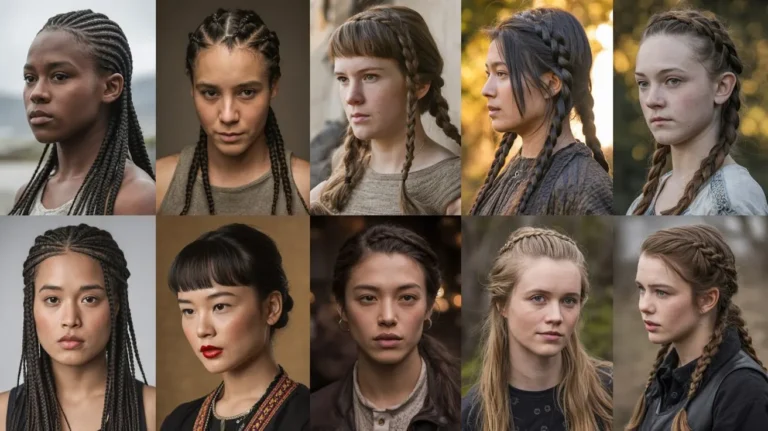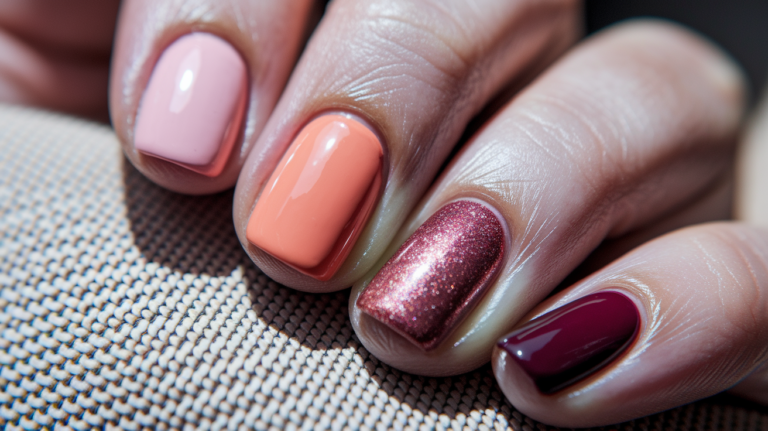Unlock Your Radiance: Pick Perfect Colors for Your Skin Tone
Have you ever put on an outfit and felt absolutely amazing, like you were glowing? Or perhaps you’ve tried on a color that just made you look a little “off” – maybe tired, pale, or simply not your best? The secret often lies not just in the style of the clothing, but in the color itself.
Colors have an incredible power to change how we look and feel. They can brighten our complexion, make our eyes sparkle, and even influence our mood. But with a rainbow of shades out there, how do you know which ones are truly “your colors”? The answer is simpler than you might think: it all starts with your skin tone.
Understanding your unique skin tone and, more importantly, your skin’s undertone, is like discovering a hidden superpower for your wardrobe. It unlocks a world of colors that naturally harmonize with your complexion, making you look more vibrant, healthier, and effortlessly chic.
This guide will take you on a journey to uncover your perfect palette, helping you choose shades that don’t just look good, but make you look incredible.
Key Takeaways
- Undertone is Key: Your skin’s undertone (cool, warm, or neutral) is more important than your surface skin color for choosing flattering shades.
- Simple Tests Reveal Your Undertone: You can discover your undertone using easy methods like the vein test, jewelry test, and sun reaction test.
- Match Colors to Your Undertone: Cool undertones shine in cool colors (blues, purples, emeralds), warm undertones glow in warm colors (earth tones, oranges, yellows), and neutral undertones can wear a wide range of shades.
- Beyond Just Skin: While undertone is crucial, also consider your hair color, eye color, and personal preference to build a truly harmonious look.
- Experiment and Have Fun: The goal is to feel confident and beautiful, so don’t be afraid to try new colors and discover what makes you feel your best!
Understanding Skin Tone Basics: It’s More Than Just Surface Deep
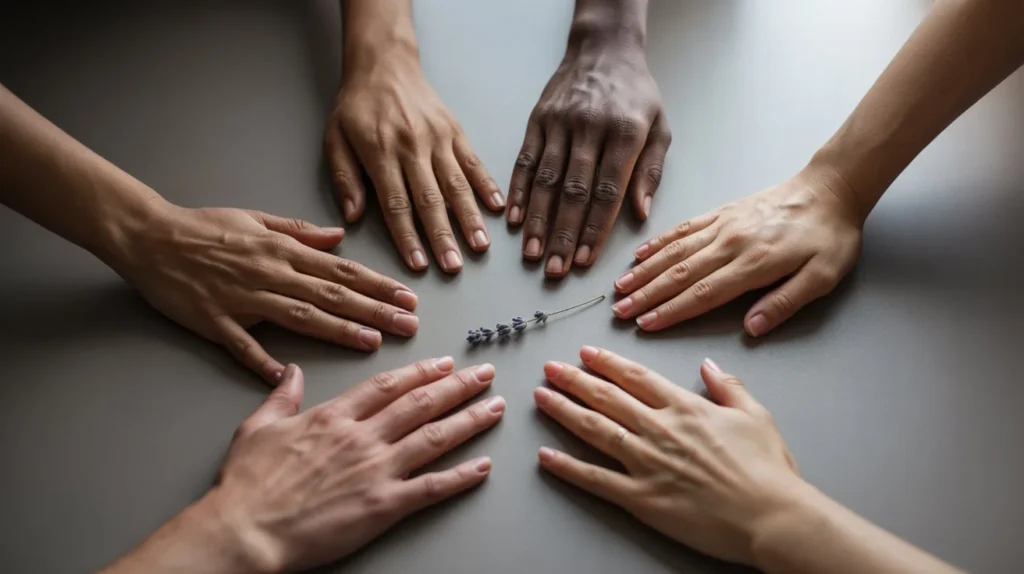
When we talk about “skin tone,” many people think about whether their skin is fair, light, medium, olive, or dark. While this surface color (also called “overtone”) is what you see at first glance, it’s not the full story. The real secret to finding your best colors lies beneath the surface, in something called your undertone.
Think of your undertone as the subtle hue that comes through from underneath your skin. It doesn’t change with sun exposure or temporary redness; it’s a permanent part of your complexion.
Understanding your undertone is crucial because certain colors will naturally complement or clash with these subtle hues, affecting how vibrant or dull your skin looks.
There are three main categories of skin undertones:
- Cool Undertones: Your skin has hints of pink, red, or blue.
- Warm Undertones: Your skin has hints of yellow, peach, or gold.
- Neutral Undertones: Your skin has a mix of both warm and cool tones, or no obvious dominant tone.
It’s important to remember that people of any surface skin color – from very pale to very dark – can have any of these undertones. For example, someone with very fair skin can have warm undertones, and someone with dark skin can have cool undertones. This is why just looking at your surface skin color isn’t enough; you need to dig deeper!
Identifying Your Undertone: Simple Tests to Uncover Your True Palette
Identifying Your Undertone
Ready to uncover your secret skin superpower? Here are simple, reliable tests you can do at home to determine your undertone. For best results, do these tests in natural daylight, without makeup, and make sure your skin is clean.
Look at the veins on the inside of your wrist. Make sure you’re in good, natural light.
- Blue or Purple Veins: You likely have cool undertones
- Green Veins: You likely have warm undertones
- Mix or Hard to Tell: You probably have neutral undertones
Hold both silver and gold jewelry (or pieces of foil) up to your skin.
- Silver Looks Best: You likely have cool undertones
- Gold Looks Best: You likely have warm undertones
- Both Look Good: You likely have neutral undertones
Hold a pure white piece of paper or white towel up to your bare face (no makeup).
- Pink or Rosy Tones: You likely have cool undertones
- Yellow or Golden Tones: You likely have warm undertones
- Gray or No Obvious Hue: You likely have neutral undertones
Think about how your skin typically reacts when exposed to the sun without sunscreen.
- Burns Easily, Rarely Tans: You likely have cool undertones
- Tans Easily, Rarely Burns: You likely have warm undertones
- Sometimes Burns, Sometimes Tans: You likely have neutral undertones
Think about what kind of foundation shades usually match you best.
- Pink-based foundations: You have cool undertones
- Yellow-based foundations: You have warm undertones
- Neutral-based foundations: You have neutral undertones
“Understanding your skin’s undertone is the compass that guides you to your most flattering colors.”
Color Theory 101: The Basics of Warm, Cool, and Neutral Colors
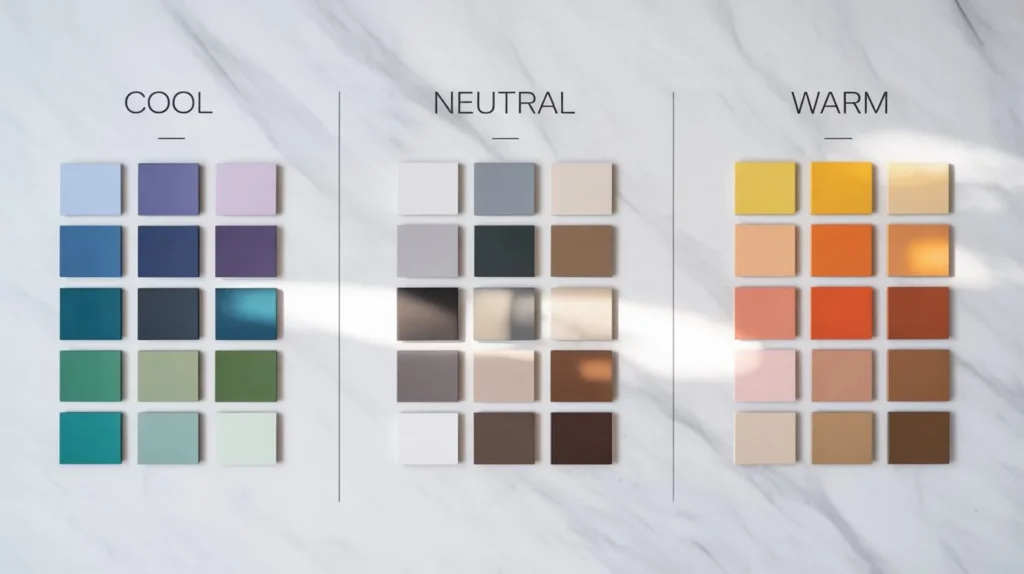
Before we dive into specific color recommendations, let’s briefly understand the basics of color theory as it relates to skin tones. Colors are generally grouped into warm, cool, and neutral categories.
- Warm Colors 🔥: These colors are often associated with the sun, fire, and earth. They have yellow, orange, or red bases. Examples include:
- Reds (tomato red, brick red)
- Oranges (peach, coral, terracotta)
- Yellows (mustard, gold, butter yellow)
- Greens (olive green, moss green, lime green)
- Browns (chocolate, caramel)
- Creams and off-whites
- Cool Colors ❄️: These colors are often associated with water, ice, and the sky. They have blue, green, or purple bases. Examples include:
- Blues (navy, royal blue, sky blue)
- Greens (emerald, jade, mint green)
- Purples (lavender, plum, violet)
- Pinks (fuchsia, rose, blush pink)
- Reds (burgundy, true red with a blue base, cranberry)
- Grays (charcoal, slate)
- Pure whites and blacks
- Neutral Colors ⚖️: These colors don’t typically have a strong warm or cool base. They are versatile and can often be worn by anyone, or they can serve as a base for an outfit. Examples include:
- Grays (light gray, charcoal)
- Taupe
- True whites
- Off-whites (cream, ivory)
- Blacks (jet black, soft black)
- Some browns (especially those without strong yellow or red undertones)
Now that you know your undertone and understand the basics of color categories, let’s put it all together!
Matching Colors to Your Undertone: Your Perfect Palette Awaits!
Your Perfect Color Palette
Now that you know your undertone, discover the colors that will make you shine! Click on your undertone below to reveal your personalized color recommendations.
- Warm golds and oranges (can make skin look sallow)
- Mustard yellows and warm browns (may clash with cool complexion)
- Icy blues and true purples (can make skin look dull)
- Ashy grays and pure whites (may drain warmth from complexion)
- Extremely bright or overly saturated colors (may overpower neutral complexion)
- Colors that are too intensely warm or cool – balanced approach works best
Beyond the Basics: Factors to Consider for a Truly Harmonious Look
While your skin undertone is the most significant factor in choosing flattering colors, it’s not the only one. For a truly harmonious and personalized look, consider these additional elements:
1. Hair Color 💇♀️
Your natural hair color plays a big role in your overall coloring.
- Warm Hair Colors: If you have golden blonde, auburn, warm brown, or red hair, you likely have warm undertones, and warm clothing colors will beautifully complement your hair.
- Cool Hair Colors: If you have ash blonde, black, true brown, or platinum hair, you likely have cool undertones, and cool clothing colors will enhance your hair’s natural shade.
- Mixed/Neutral Hair Colors: If your hair is a mix or doesn’t strongly lean warm or cool, you have more flexibility.
The goal is for your clothing color to work with your hair, not against it. For example, a cool-toned person with ash blonde hair might find that warm orange makes their hair look dull, while a cool blue makes it shine.
2. Eye Color 👀
Your eye color can also be a guide. Certain clothing colors can make your eyes appear brighter or more vibrant.
- Blue or Gray Eyes: Often associated with cool undertones. Blues, greens, and cool purples can make these eyes sparkle.
- Brown or Hazel Eyes: Can be either warm or cool, depending on the specific flecks. Earth tones, warm greens, and golds can enhance warm brown/hazel eyes, while cool blues and grays can bring out blue/green flecks in hazel eyes.
- Green Eyes: Can be warm (olive green) or cool (emerald green). Reds (complementary color!) often make green eyes pop, as do shades of purple and deep greens.
Think about which colors make your eyes stand out. Sometimes, a top in a specific shade of blue can make blue eyes look incredibly vivid, or a warm brown can make hazel eyes look like melted gold.
3. Personal Preference & Confidence 💪
This is arguably the most important factor! While guidelines are helpful, the best color for you is always the one that makes you feel confident and happy.
“The most flattering color you can wear is confidence.”
If a color is technically “not in your palette” but you absolutely love it and feel amazing when you wear it, then wear it! Fashion is about self-expression and joy. Perhaps you can incorporate it in smaller doses, like an accessory, or find a version of that color that has a hint of your undertone (e.g., a cool-toned person loving orange might opt for a coral or peach, which has some pink).
4. Occasion & Setting 🌃
The situation can also influence your color choice.
- Professional Settings: Often call for more subdued or classic colors like navy, charcoal gray, black, or deep jewel tones.
- Casual Outings: Offer more freedom for bright, playful colors.
- Evening Events: Can be an opportunity for rich, luxurious colors like deep purples, emeralds, or classic black and white.
- Season: While not a strict rule, people often gravitate towards lighter, brighter colors in spring/summer and deeper, richer tones in fall/winter.
Consider the message you want to send and the overall vibe of the event.
5. Seasonal Color Analysis (Brief Mention)
You might have heard of “Seasonal Color Analysis,” which categorizes individuals into “seasons” (e.g., Spring, Summer, Autumn, Winter) based on their skin undertone, hair color, and eye color.
This system provides even more specific palettes. While this article focuses on the foundational undertone approach, if you want to dive deeper, researching seasonal color analysis can be a fascinating next step for advanced color matching.
Common Color Mistakes to Avoid
Even with all this knowledge, it’s easy to fall into certain traps. Here are some common mistakes and how to avoid them:
- Ignoring Undertone Entirely: This is the biggest one. Wearing colors that clash with your undertone can make you look sallow, tired, or just “off,” no matter how stylish the garment is. Always start with your undertone.
- Sticking Only to Neutrals: While neutrals are safe and versatile, relying solely on them can make your wardrobe feel boring or uninspired. Once you know your undertone, confidently add pops of color that truly flatter you.
- Overdoing It with One Color: While a monochromatic look can be chic, wearing too much of a single, very bold color can sometimes be overwhelming. Balance is key.
- Not Trying New Things: It’s easy to get stuck in a rut with colors you know. Challenge yourself to experiment with new shades within your flattering palette. You might be surprised by what looks amazing on you!
- Shopping Under Bad Lighting: Department store lighting, especially fluorescent lights, can drastically alter how colors appear. Always try to view colors in natural light before making a purchase, or at least step away from the harsh lights.
- Buying Something Just Because It’s Trendy: Trends come and go. While it’s fun to incorporate them, prioritize colors that flatter you over what’s currently popular. You can always find a version of a trendy color that works with your undertone.
Practical Tips for Building a Color-Smart Wardrobe
Now that you’re armed with knowledge, how do you put it into practice?
- Start with Your Core Neutrals: Build a foundation of high-quality neutral pieces (black, white, gray, navy, beige) that work with your undertone. For example, cool undertones might prefer true black and charcoal, while warm undertones might lean towards rich browns and creams.
- Invest in Key Color Pieces: Once your neutrals are set, start adding pieces in your most flattering colors. A beautiful top, a statement dress, or a well-fitting blazer in one of your power colors can elevate your entire wardrobe.
- Accessorize with Color: If you’re hesitant to dive into a full colorful outfit, start with accessories! Scarves, handbags, shoes, and jewelry are fantastic ways to introduce flattering colors. A pop of emerald green in a necklace can brighten a neutral outfit for a cool-toned person.
- Experiment and Play: The best way to learn is by trying things on. Go to a store with good lighting and just try on clothes in various shades within your recommended palette. See how they make your skin look. Take selfies if it helps!
- Clean Out Your Closet: Once you’re confident in your undertone, go through your wardrobe. Identify pieces that genuinely don’t flatter you and consider donating or selling them. You’ll be amazed at how much more cohesive and flattering your closet becomes.
- Don’t Forget Makeup and Hair Color: The principles of undertone also apply to makeup (foundation, blush, lipstick) and hair dye. Choosing makeup with the correct undertone is just as important as choosing clothing colors.
- Trust Your Gut: Ultimately, if a color makes you feel fantastic, wear it! Confidence is the ultimate accessory.
Finally
The power of color in fashion is truly transformative. It’s not just about following trends or looking “good”; it’s about understanding your unique complexion and harnessing the magic of color to make you shine. By identifying your skin’s undertone – whether it’s cool, warm, or neutral – you unlock a personalized palette that enhances your natural radiance, makes your eyes sparkle, and gives your skin a healthy glow.
Remember, fashion is a journey of self-discovery and expression. Use these guidelines as a compass, but don’t be afraid to experiment, play, and trust your instincts.
When you wear colors that truly flatter you, you’ll not only look amazing but feel an undeniable boost of confidence. So go ahead, embrace “The Power of Color” and step out into the world, radiating your most vibrant self!

